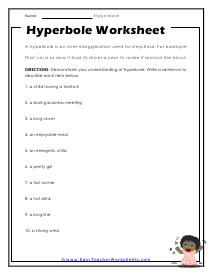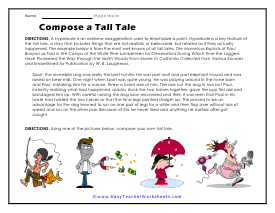Print Hyperbole Worksheets
Click the buttons to print each worksheet and associated answer key.

Tall Tales: Paul Bunyan's
A tall tale is a story that includes things that are not realistic or believable, but related as if they actually happened.


Is It a Hyperbole?
Read each sentence. If it contains a hyperbole, write hyperbole on the line. If it does not contain a hyperbole, leave the line blank.



Figurative Language Exercise
Rewrite each sentence in plain language that plainly states the point the hyperbole exaggerates.

Larger Than Life
Each sentence below expresses a simple thought in a straightforward way. Rewrite each sentence so that it expresses the same thought using a hyperbole.

Writing with Hyperbole
The paragraph below is written in plain language. Rewrite the paragraph, adding hyperbole to the underlined phrases.

Write Sentences
Demonstrate your understanding of hyperbole. Write a sentence to describe each item below.




What is a Hyperbole Used for in Writing?
Have you ever noticed how some statements sound very exaggerated? For example, if someone says I'm starving to death, it sounds like an over-the-top statement when really what they are saying doesn't make sense or can't be true. This kind of exaggeration is called hyperbole.
Hyperbole, also known as exaggeration, overstatement, or overemphasis, can be one of the most powerful tools in your toolbox when it comes to getting your point across effectively and persuasively, and it can also make some of the most mundane topics exciting and interesting to read about.
What is It?
Hyperbole is a figure of speech that uses exaggeration for emphasis or effect. The term comes from a Greek word meaning excess or overstatement. Most often, hyperboles involve using words that strongly exaggerate something.
For instance, I am so hungry I could eat a horse is an exaggeration of being very hungry. In poetry and other literary works, hyperboles are often used as figures of speech in place of similes.
What are Some Examples?
Hyperboles occur in a variety of forms and contexts. The examples below will show you how using hyperboles in your writing can really enhance its power and emotion. For example, I have told that story a thousand times. While not literally true, it conveys how often an experience has been repeated or endured.
Another common use of hyperbole occurs when we compare two dissimilar things as if they were similar: My love for her is like water on dry land while also exaggerating both components.
Examples in English Literature:
In literature, the concept of hyperboles dates back to Greek poets, who used it frequently in their compositions.
When writing Ode on a Grecian Urn, John Keats writes: Beauty is truth, truth beauty — that is all / Ye know on earth, and all ye need to know. The poet uses a metaphor here by comparing physical beauty with divine truth. This metaphor employs an instance of hyperbole to make its point.
Similarly, Shakespeare uses hyperbole in Romeo and Juliet when he describes Juliet as the sun when she first appears before Romeo: But soft! What light through yonder window breaks? / It is the east, and Juliet is the sun!
In both examples above, the authors employ exaggeration for emphasis; they do not mean to suggest that there exists a literal connection between physical beauty and divine truth or between Juliet's face and sunlight.
When Should We Use Them?
The purpose of hyperbole is to highlight something, so it should be used sparingly.
The more you use hyperboles, though, the less power they have, making them great for expressions with fewer syllables. For example, I love you! says much more than I like you a lot! Similarly, you never listen! says much more than You usually listen to but sometimes get distracted easily. Writers use hyperboles in their work to bring color and life to their writing.
The Pros and Cons of Using Hyperboles in Writing:
Yes, hyperboles are an exaggeration. But that doesn't mean they're always bad in your writing. Hyperboles have many pros, and as long as you know how to use them correctly, they can actually strengthen your writing by enhancing reader engagement, communication, and entertainment. If you want to make a point using hyperbole, do it carefully.
When used sparingly or for humorous effect, hyperboles tend to work best, but if overused, it can become obvious that what you're saying isn't true. The most common mistake writers make with hyperboles is using them too much. As with any tool, less is more when it comes to hyperbole.
Don't avoid hyperboles because you fear exaggeration. Instead, use them as creative elements in your writing to enhance and strengthen your stories or essays. If a description of a broken heart doesn't feel powerful enough without saying it breaks into pieces, then say it that way!
Project idea: Have your students read some famous Tall Tales or humorous passages, such as short stories by Mark Twain, and identify the hyperbole within them.



